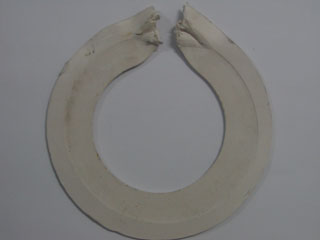The term blow out refers to the catastrophic failure of a gasketed joint. It occurs when load has been reduced to where the hydrostatic end force approaches that of the bolt load. At that point gasket stress is effectively equivalent to the contained pressure, and the joint is forced apart, causing a rapid release of pressure. The result is an instantaneous and forceful leak of the contained fluid (see Figure 1).

Figure 1. Blow out failure
Any bolted flange connection can be forced apart to the point where the gasket blows out by simply increasing the internal pressure to a point of failure. Some gasket types will rupture near their blow out pressure as the friction that retained them is overcome. Bolt area, diameter, stress and stiffness and elasticity of the joint are the major factors that determine the blow out pressure.
Role of the Gasket
Blow outs can result in two types of gasket failure modes. The first is where the gasket material loses integrity and a portion is physically ripped apart and forced from the flanged connection by the internal pressure (see Figure 1). The other is where gross leakage occurs with the gasket material remaining basically intact. Either case results in a leak, which can be dangerous, hazardous, environmentally harmful and expensive.
A common misconception is that blow out is a simple function of the tensile strength of the gasket material. However, the root cause of blow out is normally the result of a lack of sufficient bolt load and consequent gasket stress. With properly designed and installed connections, the bolt load force acting on the gasket surface is much higher than the force on the gasket ID due to the media pressure. Blow out occurs when bolt load is reduced to the point of gasket failure.
Gasket Selection and Installation
Selection of the correct gasket type and proper installation are the key factors in avoiding blow outs. Incorrect gasket selection can lead to excessive relaxation, chemical attack, heat degradation or the gasket crushing under the available bolt load. All these factors can result in a loss of compressive load and create the potential for blow out. Specifications for gaskets in each service should be developed in consultation with the manufacturer.
Gasket selection is only part of the process in avoiding the problem. Proper installation is also necessary to ensure the gasket has the sufficient load to create a seal and maintain the seal against the internal pressure. Since all gaskets relax to varying extents, especially at elevated temperature, knowing the potential amount of relaxation in the joint should be considered in the preload selection.
Flanges
Further considerations on installation include checking that the flanges are in good condition and free of cuts or excessive warpage, and piping is properly aligned. The gasket manufacturer should be consulted for the proper flange surface finish for the gasket type used. While most gasket types require 125 to 250 micro-inch AARH, some exceptions do exist. The April 2008 Sealing Sense provided guidelines on surface finishes to use for various gasket types.
Fasteners
Fasteners should be in good condition (preferably new), and an appropriate lubricant should be used on the threads and nut faces. Fasteners with sufficient strength to produce the gasket assembly stress recommended by the gasket manufacturer and maintain proper load at operating conditions should be selected. The use of hardened washers should be considered to help evenly distribute load and reduce galling.
The bolt up should use calibrated torque wrenches. If more accuracy is needed for the joint, other measures such as bolt tensioning and ultrasonic verification may be considered. With a torque wrench, generally follow a cross bolting pattern in 1/3 increments of the final torque per complete pass. Once the final torque is achieved, a rotational pattern may be followed for at least two passes until there is no further nut rotation. It is sometimes beneficial to retorque the fasteners after a waiting period. However, any further re-tightening to compensate for relaxation should only be done in consultation with the gasket manufacturer. Documents such as ASME PCC-1 provide guidelines for effective joint assembly procedures.
Conclusion
Blow outs can be avoided with proper gasket selection and installation procedures. Consultation with the gasket manufacturer before installation will help ensure that adequate stress will be maintained on the gasket during all phases of operation-from start-up to shutdown-to prevent blow out failures.
Next Month: How can packing solve my sealing problem?
We invite your questions on sealing issues and will provide best efforts answers based on FSA publications.


